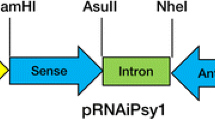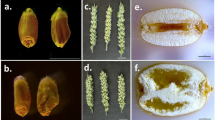Abstract
The aim of this work was to discover why pea (Pisum sativum L.) embryos recessive at ther locus (rr) have a higher lipid content than embryos dominant at this locus (RR). Ther locus is a gene encoding starch-branching enzyme,rr embryos have a much lower activity of this enzyme thanRR embryos, and hence a reduced rate of starch synthesis. The higher lipid content ofrr embryos must be a consequence of this. We suggest that neither differences in the availability of substrate for lipid synthesis as a consequence of different rates of starch synthesis, nor differences in the capacity of the pathway for malonyl-CoA synthesis, account for the different lipid contents ofRR andrr embryos. Lipid contents of the two sorts of embryo first diverge at a much later stage in development than divergence in starch content. Amounts of pyruvate and acetate, and activities of enzymes that convert triose phosphate to malonyl CoA are the same in the two sorts of embryo. Most of the lipid in developing embryos is polar, structural lipid, and polar lipid accounts for a large proportion of the difference in lipid content between the two sorts of embryo. This difference in structural-lipid content reflects considerable structural differences between the two sorts of embryo and is presumably the consequence of differences in rates of lipid turnover.
Similar content being viewed by others
Abbreviations
- DW:
-
dry weight
- FW:
-
fresh weight
- FAME:
-
fatty-acid methyl esters
References
Allen, C.F., Good, P., Mollenhauer, H.H., Totten, C. (1971) Studies on seeds. IV. Lipid composition of bean cotyledon vesicles. J. Cell. Biol.48, 542–546
Ambrose, M.J., Wang, T.L., Cook, S.K., Hedley, C.L. (1987) An analysis of seed development inPisum sativum. IV. Cotyledon cell populations in vivo and in vitro. J. Exp. Bot.38, 1909–1920
ap Rees, T., Fuller, W.A., Wright, B.W. (1977) Measurements of glycolytic intermediates during the onset of thermogenesis in the spadix ofArum maculatum. Biochim. Biophys. Acta461, 274–282
Bhattacharyya, M.K., Smith, A.M., Ellis, T.H.N., Hedley, C., Martin C. (1989) The wrinkled-seed character of peas described by Mendel is caused by a transposon-like insertion in a gene encoding starch-branching enzyme. Cell60, (in press)
Bergmeyer, H.V. (1983) Determination of metabolite concentrations with end-point methods. In: Methods of enzymatic analysis, 3rd edn., vol. 1, pp. 175–181, Bergmeyer, H.V., ed. Verlag Chemie, Weinheim, FRG
Beutler, H.-O. (1984) Acetate: determination with acetyl CoA synthase. In: Methods of enzymatic analysis, 3rd edn., vol. 6, pp. 639–645, Bergmeyer, H.V., ed. Verlag Chemie, Weinheim, FRG
Boffey, S.A., Selldén, G., Leech, R.M. (1980) Influence of cell age on chlorophyll formation in light-grown and etiolated wheat seedlings. Plant Physiol.65, 680–684
Charles, D.J., Hasegawa, P.M., Cherry, J.H. (1986) Characterization of acetyl-CoA carboxylase in the seed of two soybean genotypes. Phytochemistry25, 55–59
Coxon, D.T., Davies, D.R. (1982) The effect of ther a andr b loci on the lipid content of the seed ofPisum sativum. Theor. Appl. Genet.64, 47–50
Coxon, D.T., Wright, D.J. (1985) Analysis of pea lipid content by gas Chromatographic and microgravimetric methods. Geno-type variation in lipid content and fatty acid composition. J. Sci. Food Agric.36, 847–856
Davies, D.R. (1980) Ther a locus and legumin synthesis inPisum sativum. Biochem. Genet.18, 1207–1219
Denyer, K. (1987) The source of plastidial acetyl coenzyme A for fatty acid synthesis in plastids of developing pea cotyledons. PhD thesis, University of East Anglia, Norwich, UK
Denyer, K., Smith, A.M. (1988) The capacity of plastids from developing pea cotyledons to synthesize acetyl CoA. Planta173, 172–182
Edwards, J., ap Rees, T. (1986) Metabolism of UDP-glucose by developing embryos of round and wrinkled varieties ofPisum sativum. Phytochemistry25, 2033–2039
Edwards, J., Green, J.H., ap Rees, T. (1988) Activity of branching enzyme as a cardinal feature of theR a locus inPisum sativum. Phytochemistry27, 1615–1620
Folch, J., Lees, M., Sloane-Stanley, G.H. (1957) A simple method for the isolation and purification of total lipids from animal tissues. J. Biol. Chem.226, 497–509
Gurr, G.I. (1980) The biosynthesis of triacylglycerol. In: The biochemistry of plants, vol. 4: Lipids, structure and function, pp. 205–248, Stumpf, P.K., ed. Academic Press, New York
Hawke, J.C., Leech, R.M. (1987) Acetyl-CoA-carboxylase activity in normally developing wheat leaves. Planta171, 489–495
Hedley, C.L., Ambrose, M.J., Smith, C.M., Cook, S., Wang, T.L. (1986a) Redesigning the pea seed. In: Proc.,Eucarpia Meet. on Pea Breeding, pp. 147–163, Monti, L., ed. University of Naples, Sorrento
Hedley, C.L., Smith, C.M., Ambrose, M.J., Cook, S., Wang, T.L. (1986b) An analysis of seed development inPisum sativum. II. The effect of the r-locus on the growth and development of the seed. Ann. Bot.58, 371–379
Horowitz, J. (1983) Ultrastructural observations of cotyledons in dry and developing seeds of round and wrinkled lines ofPisum. Micron Microsc. Acta14, 207–217
Jones, A., Arthur, E., Coxon, D., Wang, T., Hedley, C. (1989) Genetic analysis of lipid in the seeds ofPisum sativum L. In: Proceedings of the Congrès international chevreul pour l'étude des corps gras. F Congr. Eurolipid, Angers, France 1989
Kellenbarger, S., Silveira, V., McCready, R.M., Owens, H.S., Chapman, J.L. (1951) Inheritance of starch content and amylose content of the starch in peas (Pisum sativum). Agron. J.43, 337–340
Kooistra, E. (1962) On the difference between smooth and three types of wrinkled peas. Euphytica11, 357–373
Lowry, O.H., Passoneau, J.V. (1972) A flexible system of enzymatic analysis. Academic Press, New York
Mollenhauer, H.H., Totten, C. (1971a) Studies on seeds. II. Origin and degradation of lipid vesicles in pea and bean cotyledons. J. Cell Biol.48, 395–405
Mollenhauer, H.H., Totten, C. (1971b) Studies on seeds. III. Isolation and structure of lipid-containing vesicles. J. Cell. Biol.48, 533–541
Morrison, W.R., Tan, S.L., Hargin, K.D. (1980) Methods for the quantitative analysis of lipids in cereal grains and similar tissues. J. Sci. Food Agric.31, 329–340
Nikolau, B.J., Hawke, J.C., Slack, C.R. (1981) Acetyl-coenzyme A carboxylase in maize leaves. Arch. Biochem. Biophys.211, 605–612
Privett, O.S., Dougherty, K.A., Erdahl, W.L., Stolyhwo, A. (1973) Studies on the lipid composition of developing soybeans. J. Am. Oil Chem. Soc.50, 516–520
Roughan, P.G., Holland, R., Slack, C.R. (1979) On the control of long-chain-fatty acid synthesis in isolated intact spinach (Spinacia oleracea) chloroplasts. Biochem. J.184, 193–202
Rouser, G., Kritchevsky, G., Simon, G., Nelson, G.J. (1967) Qualitative analysis of brain and spinach leaf lipids employing silicic acid column chromatography and acetone for elution of lipids. Lipids,2, 37–40
Simcox, P.D., Garland, W., De Luca, V., Canvin, D.T., Dennis, D.T. (1979) Respiratory pathways and fat synthesis in the developing castor oil seed. Can. J. Bot.57, 1008–1014
Slack, C.R., Roughan, P.G., Balasingham, N. (1978) Labelling of glycerolipids in the cotyledons of developing oilseeds by [1-14C]acetate and [2-14C]glycerol. Biochem. J.170, 421–433
Smith, A.M. (1988) Major differences in isoforms of starch-branching enzyme between developing embryos of round- and wrinkled-seeded peas (Pisum sativum L.). Planta175, 270–279
Smith, C.M. (1986) Genetic variation for fruit development ofPisum sativum L., with special reference to the effects of therugosus locus. PhD thesis, Plymouth Polytechnic, Plymouth, UK
Turnham, E., Northcote, D.H. (1983) Changes in the activity of acetyl-CoA carboxylase during rape seed formation. Biochem. J.212, 223–229
Wang, T.L., Smith, C.M., Cook, S., Ambrose, M.J., Hedley, C.L. (1987) An analysis of seed development inPisum sativum. III. The relationship between ther locus, the water content, and the osmotic potential of seed tissues in vivo and in vitro. Ann. Bot.59, 73–80
Author information
Authors and Affiliations
Additional information
This work was supported by a grant-in-aid from the Agricultural and Food Research Council to the John Innes Institute. We are very grateful to Alan Jones for his valuable advice on lipid analysis and to Dr. Kay Denyer (Advanced Technologies, Cambridge, UK) for valuable discussions. We thank Dr. Cliff Hedley for the gift of the seed of the peas used in this work.
Rights and permissions
About this article
Cite this article
Bettey, M., Smith, A.M. Nature of the effect of ther locus on the lipid content of embryos of peas (Pisum sativum L.). Planta 180, 420–428 (1990). https://doi.org/10.1007/BF01160399
Accepted:
Issue Date:
DOI: https://doi.org/10.1007/BF01160399




